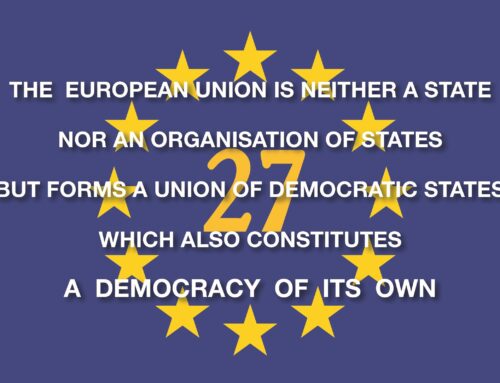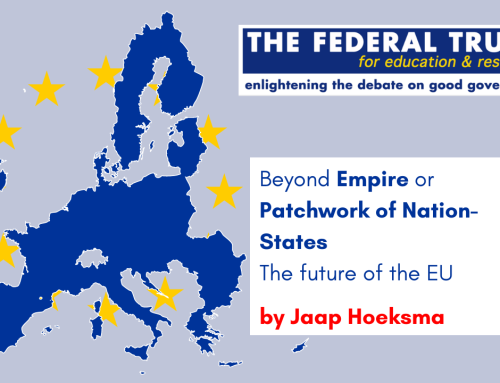Presentation by Dr Hywel Ceri Jones to the European Conference on Higher Education and European Integration held at the European University Institute in Florence on 29th October 2016 on the occasion of the Institute’s 40th anniversary
by Dr Hywel Ceri Jones, Council member, The Federal Trust
Firenze, October 2016
Thank you warmly for your invitation to be here to celebrate the birthday of the Institute. I had the privilege to represent the European Commission on the Institute’s Governing Board for the first 15 foundation years of its development. I am happy to have the opportunity to be here at the Institute once again.
As requested by the organisers I shall this morning highlight the key points of significance drawn from my personal experience in the European Commission over a 20 year period in developing European educational cooperation and especially the Erasmus programme.
The Erasmus+ and Horizon 2020 programmes are now two of the key centrepieces of the EU’s 2020 strategy. By 2020, the Erasmus programme will have involved more than 5 ½ million students, engaged most European higher education institutions and now through Erasmus Mundus connects universities across the globe with its quality Erasmus brand widely recognised. What a dramatic change since the 1970s in the place of education, training and research now at the heart of the EU’s strategy of development.
The original kick start took place in 1973, the year Denmark, Ireland, and the UK joined the then EEC as new members, making a total of 9 member states. Now, of course, its membership is three times as great, after several further enlargements of the EU. The year 1973 was also special because it saw the creation of the European Commission’s first Education and Youth department. This was the direct result of the personal initiative of Commissioner Altiero Spinelli in the retiring Commission. Spinelli had the vision to argue for a strong educational dimension as absolutely vital to the construction of an open and democratic Europe. I was privileged to be appointed as its first Head of Department, with the challenge of preparing proposals for a European education action programme.
The immediate political challenge was to demonstrate that educational cooperation would not imply or lead to harmonisation or standardisation of the different educational systems, and that the Commission would not work through proposals for binding legislation on the member states, its traditional method of operation in fields such as agricultural policy and the customs union, which required common European rules.
The word ‘education’ did not feature in the original founding Treaty of Rome and had been previously “taboo” on the European political agenda. It is true that there had been a number of attempts made during the 60s to open cooperation on education, but they had all faltered particularly because of the insistence of the French authorities at that time on adopting a purely intergovernmental approach, which would have excluded the Community institutions from playing a catalytic and organising role.
The choice of Professor Ralf Dahrendorf in 1973 as Commissioner with responsibility for education, science and research was particularly inspiring. His charismatic presence and internationally recognised academic credibility were important factors in preparing the first significant breakthrough on education in negotiations with the European Ministers of Education.
This first action programme was adopted in February 1976 on the basis of a mixed Resolution of the Council and Ministers meeting within the Council. This double formulation was negotiated, with difficulty, as a special political (at that time unique) formula so as to recognise that there was some (deliberately unspecified) justification provided by the Treaty of Rome (most evidently in relation to the education of migrant workers), whereas other educational actions fell under the exclusive competence of Member States – reflecting a mixture of intergovernmental and communautaire competence.
The original concept underlying the Erasmus Programme dates back directly to this first education action programme which was adopted in 1976, when the European Education Ministers agreed for the first time to establish a programme of close cooperation between the educational systems of the EEC.
As one of their agreed priorities, Ministers decided to ‘promote joint courses of study between universities and higher education institutions’. In effect, this was the first formulation of the core idea behind the Erasmus programme as it subsequently developed. I had proposed to the Commission and to the newly established Education Committee in the Council the idea of joint study programmes as a result of my experience when working previously at the University of Sussex (the first of the 7 new universities in the UK in the 1960s), where its School of European Studies broke new ground by providing an organised opportunity for all its students, whatever their major discipline – not only for linguists – to pursue a year abroad as an integral part of their degree programme. I was convinced that such an idea could be developed on the European stage.
It took what was in practice a 10 year development phase to clearly demonstrate that the scheme could work in practice, despite the diversity of systems and approaches, with the enthusiastic backing of universities and students across Europe. The pioneering experimentation we initiated during this period with credit transfer and modular units of study (the ECTS) proved to be full of promise for larger scale development. At a time of diminishing national budgets for higher education in the 1980s, the European Community (as it was then called) was seen as a new source of innovation and intellectual inspiration as well as a new source of financial support.
The Commission broke new ground too in its handling of the EU education programmes by delegating under contract their day to day running to a dedicated team of specialists familiar with the European higher education scene, who were equipped to and capable of advising universities and senior academic staffs on the opportunities for and conditions of partnership building across national frontiers.The enthusiastic and committed cooperation of the European Culture Foundation , and its European Institute of Education and Social Policy, made possible the high quality underpinning of the Erasmus programme, paving the way to similar operational arrangements when the Commission also externalised responsibility for the successful day to day running of the Comett and Tempus programmes . The combination of the policy oversight and direction given by the Commission ‘s team together with the dedicated and highly professional support of the external Erasmus team was a critically important factor in building the credibility and quality of this European cooperation.
During this period the Gravier judgement in 1985 issued by the European Court of Justice certainly had a profound influence on the legal debates on the place of education and training in the Treaty. A case had been brought by a student who was a French national who wished to pursue a course in cartoon design at a Belgian art school. She took the Belgian authority, the City of Liege, to court on the grounds that as an EC national she should have been given a place on the same terms as Belgian students and not charged the higher foreign student fee, called the minerval. The European Court had in fact accepted that there should be no discrimination between EC (now EU) nationals in terms of access to training and that the word ‘training’ ( case-law 294/83 Gravier (1985) ECR 593) should be deemed to cover university education.
With the explosion of enthusiastic support and effective lobbying of Prime Ministers and Presidents (including the reluctant Mrs Thatcher) at the London European Summit, the Programme was officially launched in 1987. The outstanding leadership qualities of Jacques Delors as President of the European Commission undoubtedly played an important role in the Summit. A crucial role was played by a group of European Rectors led by Rector Roger Dillemans following a seminar at Leuven University when all the rectors present agreed to lobby directly their respective prime ministers in the European capitals prior to the London summit.
The programme made a huge quantum leap at this point in the size of EU budget allocated to it and in the numbers involved. The official title Erasmus, with its historic symbolism and immediate appeal, also worked perfectly as an acronym – European Community Action Scheme for the Mobility of University Students (or as I preferred Studies.)
The negotiations which led ultimately to the adoption of the Erasmus and Comett programmes owed a great deal to the determination and dynamic leadership of Commissioners Peter Sutherland and Manuel Marin, both of whom were passionately attached to winning what turned into a difficult confrontation in the negotiations within the Council, notably with the three largest Member States because of their challenge to the legality of the basis in the Treaty to approve and finance these programmes. It was a special privilege this morning to hear the contribution from Manuel Marin recalling the difficult negotiations in which he was so centrally involved.
The 1992 political target set at that time by the Heads of State of the EU for the completion of the Internal Market also gave considerable momentum to the Erasmus and Comett (university-industry collaboration) initiatives as well as attracting significant public and private sector support for them. (The four freedoms – of goods, services, capital and of labour – were at the heart of the internal market agenda.) There followed many signals that young people wished to make their careers and plan their education and training in a European context. This coincided with the growing Europe-wide concern, and consistent backing of the European Parliament, to invest in people, in their skills, their creativity and versatility as a powerful force for economic development.
Education and training moved up the European political agenda. The growing mutual confidence between the different educational authorities coupled with and indeed fuelled by the dynamic of the Erasmus and Comett programmes, certainly contributed to the successful negotiations which led to the introduction of a new chapter on education and vocational training policy in the Maastricht Treaty in 1993. This provided a clear legal basis for the future. That made it possible subsequently for the EU budget to be drawn on to finance the Erasmus programme. To my mind it represented the natural culmination of everything that the development work of the period from 1976 had sought to demonstrate. The wording of the two articles in the treaty made it totally clear that any idea of harmonisation of the education and training systems was ruled out. The explicit formulation of the primary responsibilities of Member states on education policy and the complementary role of the EU was a perfect example of subsidiarity written into the treaty.
Looking back now, I recognise the importance that the initial 10 year period of development and try-out played as a necessary phase of experimentation and confidence building. The basic architecture of the Erasmus programme has in fact remained to this day fundamentally the same over the whole period though its overall budget has grown massively over the years and according to President Juncker last week in Brussels is likely to be further expanded in the proposals in preparation for the Commission’s White Paper next March, 2017.
Whilst the organised mobility of students within Europe was, and continues to be, the idea that has caught the wider popular imagination, the keys to its continuing long-term success lie in the basic architecture of the programme. Let me highlight briefly now the three features which have been critically important to the sustainable impact and quality of the Erasmus programme on the higher education scene in Europe.
Firstly, the decision to open up Erasmus to students of all disciplines was to my mind perhaps the most significant innovation. Present and future labour market opportunities required graduates in all fields, not only law, economics and business studies, with the capacity to work across the cultures through the medium of at least two and preferably three languages. In the early days combinations of business studies with foreign languages proved to be the most popular, then law, engineering, manufacturing and construction all experienced strong take-up together with the humanities, social sciences, and the arts.
Secondly, the programme was conceived from the very beginning to promote initiatives from the grassroots level on an entirely voluntary and decentralised basis, and not through the national authorities. The power of initiative was placed firmly in the hands of universities themselves to seek and develop partnerships abroad. With their own degree-awarding powers in most European countries, Universities were to be the initiators and drivers of the process.
It was essential to have the assurance of their institutional commitment to, and responsibility for, the quality of the arrangements for cooperation. This institutional engagement on the part of the university authority was seen as a sine qua none for a lasting long-term effort which would embed the capacity to mount such joint degrees or joint ventures. University authorities were in particular expected to give the assurance that the period of study spent abroad would be fully recognised as a necessary and integral part of the students’ final qualification, and that it would be explicitly presented as such in the final degree or certificate.This precondition is now a key component of the Erasmus Charter which participating universities have to sign when committing to participation in the programme. Extensive evidence suggests that employers throughout Europe have consistently recognised the plus value of this extra dimension in their recruitment policies and that former Erasmus students perform very successfully i
The decentralised approach adopted by the Commission had led many universities to set up their own Erasmus or European offices to assist in institutionalising their partnership agreements, and committing themselves institutionally more than ever before to a process of internationalisation of their teaching and study programmes. This commitment provided important backup to the vital decision which we also negotiated that the Erasmus programme should be underpinned by reciprocal cross-national arrangements regarding the financing of such exchanges, including the waiving of tuition fees, and the provision of Commission top-up (complementary) grants to participating students towards their travel and subsistence, which would complement the different national systems of student financing .
The third decision that has continued to make all the difference in the development of Erasmus was to make grants to academic and administrative staffs to help them to reconnoitre possible partners abroad and to plan with their partners and prepare the necessary quality conditions governing the teaching and assessment of the joint courses. Over the years this has helped build up mutual trust and professional friendships, and enhanced mutual understanding of the different national systems and structures of curricula and degrees as well as generating widespread confidence in the collaborative schemes. By this year over 400,000 grants have been awarded for both teaching and staff training assignments – so crucial to changing the European educational landscape.
Looking back over the years, we can now see that the Erasmus programme, and its European credit transfer scheme, (ECTS), have contributed in a significant way to the reform process in the EU higher education scene. Together with the growing impact of the Horizon 2020 programme and the training of doctorate students, these developments have undoubtedly contributed to the development of the Bologna process which is contributing so much to enhance the quality of higher education reform throughout Europe .This European –wide process of reform has capitalised on the mutual trust and confidence which has grown progressively through participation in the Erasmus programme. This reflects the positive direct experience of many universities, their academic leaders, and the thousands of academic staff involved in mounting joint or combined degrees, thereby enhancing their appreciation both of the diversity and the common ground to raise the quality of higher education in Europe.
Alongside the impact of the Bologna process ,we now have evidence of the increasing networking of former Erasmus students and alumni emerging throughout the world. Many of them are cooperating to promote innovative schemes of collaboration internationally with their shared interest in developing entrepreneurial projects which cut across national boundaries . They are playing a crucial role in ensuring that the Erasmus programme and its ambitions will continue to flourish in the years ahead as a flagship at the heart of what the EU stands for.






